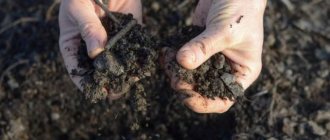The condition of the planted rose depends on the quality of the prepared soil.
You cannot plant rose seedlings in the old place, as the soil there is depleted and infected with various pests and pathogens.
Young bushes feel bad there, get sick and often die. In such an area, the soil layer is removed to a depth of 50-70 cm and fresh soil is added.
The soil must contain fertilizers - manure and mineral additives. The depth of the nutrient layer of soil for grafted roses should be up to 70 cm, and for self-rooted roses at least 50 cm.
What soil do you need for roses?
Roses are capricious garden plants; they are sensitive to soil moisture and acidity. The only type of soil in which rose bushes of any kind will not grow is swampy.
Planting roses requires proper soil preparation
For your information! Even for rocky soil, you can choose dwarf varieties, but if there is excess moisture in the soil, the root system will begin to rot. The above-ground part of the bush will quickly die without ever getting stronger.
Roses love loamy soil with a high humus content, where they quickly grow stronger and bloom lushly. You can create soil for garden roses yourself, for which you need to find out the type of soil and add the necessary fertilizers.
- sandy soil. It is required to add clay for weighting;
- clay soil. Coarse sand will make it softer;
- swampy soil. You will have to add clay, sand, compost and lime to it;
- loamy soil. It is enough to add compost.
If the composition of the soil for roses is extremely poor, you can buy ready-made soil and pour it into the hole.
Important! It is strictly not recommended to plant rose bushes where others have recently grown.
It’s not even that the soil is depleted; pests that attacked previous plants could also remain in it. If you cannot find another place, then before planting you need to update 50-70 cm of the top layer of soil in order to protect the plantings.
Roses need nutritious fresh soil, as well as pruning of damaged shoots before planting.
Novice gardeners do not pay attention to the properties of the soil in their area. It seems to them that it is enough to know its type (rocky, clayey or sandy) in order to properly care for the garden. However, to grow rose bushes you need to know what kind of soil roses like - acidic or alkaline. These capricious flowers prefer slightly acidic soil, which is ideal for them. This property can be determined using a special indicator (like a litmus strip), which is sold in a gardening store.
For your information! Chamomile, red clover and coltsfoot usually grow in slightly acidic soil. Preferred fertilizers are peat and manure.
Preparation of soil substrate for propagation of roses by seeds and cuttings
For propagation of roses, it is optimal to take light, sandy loam soil. It should not be oversaturated with nutrients, as this, on the contrary, will complicate and slow down rooting.
You can buy ready-made soil in the store. A universal one is well suited for growing seedlings. However, it makes sense to prepare the soil yourself so that the rose initially adapts to the soil in which it will grow.
When deciding to prepare a soil mixture with your own hands, it is important to take into account a number of requirements. The acidity should be neutral. There should be no weeds in the soil. It should be light and moderately nutritious. Pre-selected soil can be baked in the oven to make it sterile. Especially if you have previously noticed that the plants in your area often get sick.
The soil for the seeds is prepared especially carefully, as they germinate very slowly. By the way, it is not customary to propagate roses by seeds, since in this case there is no guarantee that the young rose will retain the characteristics of the mother plant. This is due to artificial selection over several centuries. Having planted a rose as a seed, you can never know in advance what will grow from it.
How to determine soil acidity
The optimal soil acidity level for planting roses is 5.5-6.5 pH, which corresponds to slightly acidic soil. There are several ways to find out what this level is near the ground in the garden. The most reliable way is to purchase a well-known acidity indicator, namely, litmus paper at a pharmacy or household chemicals store.
What soil does indoor and garden hydrangea like?
A soil sample taken from the proposed planting site is dried and placed in a container. After this, it is poured with distilled water and stirred. Now you need to attach the litmus paper to the wall of the vessel (inner, of course) and wait 30 seconds. During this time, a color will have to appear on it, which must be compared with the scale attached to the measuring material.
Below we will consider a popular method of measuring soil acidity, but it cannot be recommended for an accurate result. It will only indicate the general type - alkaline, neutral or acidic. This is not enough for roses, but it will at least allow you to understand what fertilizers need to be applied.
Note! Electronic meters show the best accuracy; you just need to stick them into the ground, and the result will appear almost instantly. Their only drawback is the cost, but an avid gardener will undoubtedly find such a thing useful in their work.
Picture 3 Before planting roses, you need to measure the acidity level of the soil
The popular method of measurement is as follows: the future soil for roses is placed in two jars and filled with distilled water. Then pour soda into one container and vinegar into another. If there is a reaction to soda, the soil is acidic, if to vinegar, it is alkaline. If the soil has not reacted in any way, it is pH neutral.
Important! It is not recommended to use a mechanical meter as it is not accurate.
Sorrel, plantain and horsetail grow well in acidic soil, and potatoes and strawberries grow well in acidic soil. Carrots and tomatoes are tolerant of high levels of acidity.
Measures to optimize the mechanical composition of different natural earth structures
The composition of the soil for growing roses is also very important and has a direct impact on the health of the bush.
The ideal soil for this is light loam. Such soil allows air to circulate freely around the roots, moisture does not stagnate, and at the same time, nutrients are retained in the soil for a long time.
Determining the type of soil is quite simple. You just need to take a handful of earth in your hand and pass it between your fingers. Sandy soil is too loose and does not form lumps. It spills out of your hand. Loamy soil is loose and crumbly. Forms lumps that do not stick together. It passes through the fingers in small lumps. But clay soil will remain in your hand, as it sticks together and does not crumble at all.
How to make soil nutritious for roses
How to acidify soil for hydrangea - methods and proportions
The correct answer to the question is what kind of soil do roses like - fertile and fairly loose. Therefore, fertilizing and preparing drainage before planting are necessary. To make the soil nutritious, you need to adjust the acidity level. To plant a flower in a pot, it is best to purchase ready-made soil. The success rate of seedlings becoming established depends on their quality: if they are healthy, they will be able to establish themselves in almost any soil.
Important! You shouldn’t even try on swampy and saline soils, as they are unsuitable for growing roses. In other cases, you can improve the composition of the soil and safely plant future garden decorations.
How to improve the soil in one case or another:
- clay soil is well nourished by a mixture with sand: 1 part each of humus, compost, turf and leaf soils and 6 parts of coarse sand;
- loamy soil can be improved if a nutrient mixture is added to it: 1 part each of turf, humus, compost and 3 parts sand;
- sandy soil needs clay: 1 part each of compost, humus, turf and 2 parts clay powder.
If you can’t prepare the soil mixture yourself at home or don’t want to, you can purchase ready-made soil for planting in the store. In this case, it is better to consult the seller, providing him with information about the acidity of the soil and varieties of roses.
Note! Humus, compost and turf can be replaced with one component - vermicompost, which makes the soil nutritious.
Nutrient mixtures will help prepare the soil for roses
Preparation of young seedlings
◊ Escapes. We need to cut off all damaged and dried shoots under the first bud.
Healthy shoots must also be pruned, but (for stronger seedlings, 5 buds are left, for seedlings of average strength and quality, 3 buds; if the seedling is weakened, the shoots must be shortened to almost the entire length, leaving 3 mm at the base).
When planting roses in spring, we save:
- Floribunda: 3-4 buds.
- Hybrid tea species: 2-3 buds.
- Low-growing polyanthus: 2-3 buds.
- Rambler climbing groups: shoots are cut to 35 cm.
- Tall: shoots can be shortened by 10-15 cm for early flowering.
- Miniature and park varieties are not pruned; the shoots only need to be slightly refreshed (trimmed the tops).
◊ Roots. We inspect the roots: we cut off the dented ones, we dive the good ones 1-2 cm from the tip. Then we dip the roots into a solution of water and “Kornevin”, keeping them there for several hours.
Before planting roses, the roots of the plant are cut to 20-25 cm, damaged ones are removed until healthy tissue begins to appear.
The day before planting, place the roses in a container with water for 11-12 hours. Then we moisten the roots with a mixture of clay and mullein (proportion 3x1), adding a heteroauxin tablet to a bucket of solution (pre-dissolve the tablet in water).
Packaging Features
Rose seedlings can be found in completely different packages. Features of the form in which the young rose was sold must be taken into account when preparing the plant for planting:
♦ Polyethylene cylinders. Baltic producers like to pack rose seedlings in plastic tube cylinders without a bottom.
The plants are in this packaging from the very moment of grafting, so they can be easily planted without destroying the earth ball. But before you plant, carefully inspect the roots.
- If the roots are light and directed outward, the plant can be planted immediately. And if there are few light roots, they are tangled - in this case, carefully straighten the roots and cut off the dry ones. It is imperative to ensure that the roots are directed outward and downward. If seedlings in cylinders need to be preserved, store them in a pot, first freeing them from packaging.
♦ Seedlings grown on light peat in greenhouses. Based on the experience of gardeners, such seedlings need to be planted by disturbing the earthen ball (by the way, contrary to many literary instructions).
As a rule, the pots of such seedlings are small, and the roots tightly entangle the ground, forming a kind of “felt”. The roots cannot get out of such a coma on their own; roses do not take root in a new place for a long time and often die.
- Be sure to remove the seedling from the pot before planting and soak it in water so that all the air comes out of the earthen ball. Then use a sharp knife to remove the outer layer of roots. Wash the roots of the seedling from the soil, but do not touch them at the base. Then straighten the roots and plant the rose.
♦ Mesh packaging. The manufacturer says that seedlings in a mesh container can be planted directly in it. But according to the experience of gardeners, planting roses in a net very often gives poor results. The seedlings take root poorly.
Therefore, try to partially disrupt the integrity of the mesh before planting and straighten the surface roots (by cutting off rotten or dry ones).
Mulching and mineral fertilizers
Is it necessary to bury a rose graft when planting?
Regardless of whether the rose is indoor or garden, it prefers warmth; cold is not suitable for these flowers. But at the same time, rose bushes do not like the scorching sun, as it leaves burns on the petals and leads to dehydration of the plant. Mulching the soil for roses will provide excellent protection for the top layer of soil. It is especially necessary if the bushes are not planted closely, but far from each other.
Note! Lawn grass or sawdust can be used as mulch, but it is important that moisture does not accumulate under it. An alternative method of soil mulching is to plant low-growing plants so that they cover the roots of the roses.
Mineral fertilizers are applied in early spring to prepare the soil after winter. They cannot be used during the flowering period, so it is not recommended to be late with early flowering varieties. However, some gardeners consider such fertilizers to be an extreme and not entirely necessary measure, replacing them with HB 101. It is a squeeze of cedar, pine, cypress and plantain. It contains 6 mineral elements and is a growth stimulator for flowers.
The drug improves the plant's immunity and increases resistance to disease. It is available in two types; granules are suitable for root feeding. It is enough to put a few pieces in the hole for the seedling and be calm about the care with mineral fertilizing. If the soil is poor, you can add a liquid solution every 3 weeks.
Roses need a large depth of the planting hole, this is a necessary condition
Common mistakes gardeners make are insufficient depth of the planting hole and lack of drainage. The depth and width of the pit should reach 70 cm, the top layer is carefully laid on its edge. Drainage is laid out at the bottom of the hole - pebbles, crushed stone or other material. A thick layer (about 40 cm) of prepared soil is poured on top, and a fertile layer of soil for roses is placed on it.
Important! Along with drainage for roses in the garden, you need to take into account the fertility of the soil: the lower it is, the greater the depth of the cultivated soil.
Old methods should also not be forgotten, for example, a clay mash perfectly nourishes the roots of a rose seedling before planting. To do this, you just need to combine equal parts of manure and clay, obtaining a creamy consistency. The rhizome is dipped into it before planting for 8-10 minutes, after which it is planted in a hole.
Hello, dear readers!
Let's continue the conversation about the rose - about this magical creation of nature.
From previous articles, we learned what to consider when choosing a rose variety for your garden and how to choose high-quality seedlings.
Now another concern has come to the fore - proper planting of roses .
The time has come for our beauty to grow up and start living in the garden, delighting her owner with the delicate fragrance.
But this will be provided that the owner knows how to plant roses correctly and skillfully approaches this important mission.
After all, planting roses is one of the most important events on which the fate of the rose bush depends.
How to determine soil moisture
This criterion will allow you to understand whether the soil is loose enough for roses, since damp soil is not suitable for them. No special equipment is needed here; you just need to take a handful of earth in your hand and squeeze. If it does not roll into a ball and crumbles back, its humidity is close to zero, so nutrition is needed. If it connects, but not for long, the humidity is no more than 30%, which is a little low for roses. This means that the soil needs watering. An acceptable degree of humidity for roses is one at which the soil rolls into a ball and does not crumble back.
Important! If the soil hardly crumbles into separate parts from a wet lump, it is not suitable for planting roses.
The soil for roses should be sufficiently moist
The queen of the garden rose cannot be planted in any place where it will look most impressive. It is capricious to the properties of the soil, so you will have to do a little research. Once the acidity level of the soil is determined, the correct nutrient mixtures can be added to make it suitable for planting roses.
When is the best time to plant
Roses can be planted in two periods: spring and autumn. In the conditions of central Russia, it is safer (according to experts) to plant in the spring.
But provided that the soil warms up to +10-12° C and before the buds begin to open.
As a rule, this is mid-April to the second ten days of May.
- Ideally, root-capable seedlings are taken in containers. Plant them only in the spring by transferring an earthen clod. For many varieties of roses, only spring planting is acceptable (ask about this nuance when purchasing shoots).
But planting roses in spring has its drawbacks. Such roses may be stunted in growth (compared to autumn seedlings). This lag is approximately two weeks.
Also, such queens are more capricious and require more supervision and care.
It is better to plan autumn planting of roses for mid-September to mid-October.
If the timing of the event is postponed, the roses will not have time to get stronger before the first frost. It is very important that the plant buds have not yet begun to develop.
- 10-12 days after autumn planting, roses form small young roots, which manage to gain strength before frost and feel great in a dry shelter until spring. In spring, young plants very quickly begin to form a strong, healthy bush.
If you don’t have time to plant in the fall and don’t want the seedlings to disappear, you can try to save them until spring by burying them.
To do this, shorten the stems and trim the roots to 30 cm. In this case, callus forms on the roots (a callus that appears at the site of the wound). Healthy roots will develop from the callus in the spring.











